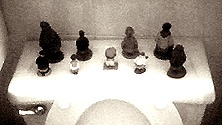L'ATELIER
ROBERT COANE
- THE CARAMEL AWARD -
 |
 |
for the
WORST
ART DEAD OR ALIVE ,
blunders
and Art-rageous attacks against Art
and Artists
...and
this special edition Spring 2006

![]()

![]()
goes to...
|
london
art dealer GEORGE
WACHTER
|
On
2 May Sotheby's New York will auction off a suite
of 19 watercolors
by the English artist, poet, mystic and visionary William Blake
(1757-1827), illustrations created in 1805 for Robert Blair's poem, "The
Grave",
a spiritual narrative portraying the allegorical stages in the soul's progress.
Of the initial 20 illustrations, one is owned by Yale University's
Center for British
Art, which received it as a gift from its founder, Paul Mellon. They are to
be
broken up and individually sold at Sotheby's for a projected $12 million to
$17.5 million rather than attempting to keep the collection together.
To break up the suite is, to say the least, unconscionable.
"This is an auction that should not take place,"
says the New York Times
"It's
not complete, so in a sense it's already been broken up," said
George Wachter,
director of old-master paintings for Sotheby's
worldwide. "Since one of them is at Yale, it makes the most sense to
do it this way," he said of his decision to auction them one by one.
The same rational is offered by art dealer Libby
Howie, who owns the lot.
SOUNDS
LIKE A SOUND BITE STRAIGHT OUT OF THE BUSH...
( I hear Karl Rove has been roving Sotheby's of late.)
The
motivation here is clear:
PURE, UNADULTERATED
GREED!!!
To hell with
purpose or intent, to hell with scholarship!
We
still hope somehow there will be a way to keep the suite together.
Perhaps the Center
for British Art or
some Yale alumni will come forth.
(WHERE
ARE YOU, BILL GATES?!?)
At the onset, the Tate
Britain was interested but found it unaffordable.
Please read the following New York Times Editorial
and accompanying
article by the Times' Carol Vogel
for a detailed timeline of this story.
I have
included ten of the watercolors here. To view all 19 pieces
click on the 1st illustration below, the title page.
I ask
that, if you are moved by this sequence of events, you take a moment to e-mail
Henry Wemyss, Senior
Director
Head of Department
British Drawings and Watercolours
henry.wemyss![]() sothebys.com
sothebys.com
(click
on @ to access e-mail)
Request a stay.
• • •
FOLLOW
UP / OUTCOME/ CONCLUSION |
Rare
Watercolor Collection Auctioned Piece by Piece
The unthinkable / unavoidable happened....
But what a surprise to seller, London dealer Libby
Howie who got her right deserves!
Ms Howie, who hoped to score millions on her purchase at a paltry
$7.7 million got
an even paltrier $7.1 million!!!
A loss!
Hey, as John Lennon said in song...,
"WHATEVER GETS YOU
THROUGH THE NIGHT"
SHE
SURE GOT HER "COME-UPPANCE" !
 DOUBLE
CARAMEL
DOUBLE
CARAMEL
 for
Lady Libby Howie.
for
Lady Libby Howie.
Scroll
down or click on image below for full NYTimes coaverage.
|
"The
Skeleton Reanimated" Inscribed Title Page
for "The Grave" A Poem by Robert Blair |
|
EDITORIAL |
|
|
|
|||
|
|
|
|||
|
|
|
|||
|
|
|
|||
|
|
|
|||
|
|
|
|
Art
Experts Protest Sale of Rare Set of Blakes |
FOLLOW
UP / OUTCOME |
|
Rare
Watercolor Collection Auctioned Piece by Piece |
|
ROSTER
OF HORROR |
Click on images
for Archive

|
 |

|
 |

|
 |
|
 |
|
|
 |
 |
 |
 |
 |
 |
 |
|
|
 |
|
|
 |
 |
"Nor
wonder how I lost my wits;
Oh! Celia, Celia, Celia shits!"
- Jonathan Swift
WE HUMBLY ACCEPT NOMINATIONS
TO SUBMIT
E-mailrcoane
The
criteria, views and opinions expressed in the CARAMEL AWARD are exclusively
those of Robert Coane who is solely responsible for its
content and do not necessarily reflect the opinions or views of the other
participants in www.Atelier-RC.com or of the members of L'Atelier.
> |
> |
> |
CARAMEL
AWARD |
ROBERT COANE 2002 to 2006 © All rights reserved










































